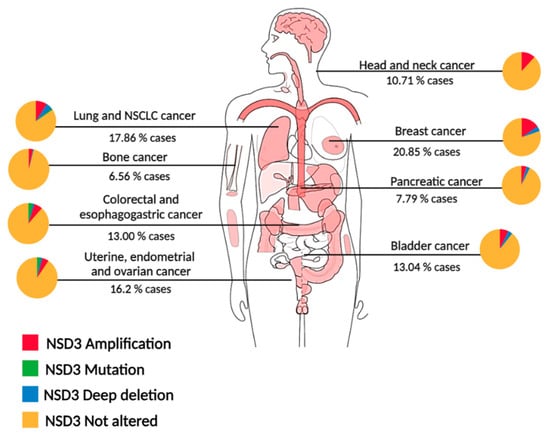NSD3 (nuclear receptor-binding SET domain protein 3 (NSD3) is a member of the NSD histone methyltransferase family of proteins. In recent years, it has been identified as a potential oncogene in certain types of cancer. The NSD3 gene encodes three isoforms, the long version (NSD3L), a short version (NSD3S) and the WHISTLE isoforms. Importantly, the NSD3S isoform corresponds to the N-terminal region of the full-length protein, lacking the methyltransferase domain. The chromosomal location of NSD3 is frequently amplified across cancer types, such as breast, lung, and colon, among others. This amplification has been correlated to a chromothripsis event, that could explain the different NSD3 alterations found in cancer. The fusion proteins containing NSD3 have also been reported in leukemia (NSD3-NUP98), and in NUT (nuclear protein of the testis) midline carcinoma (NSD3-NUT). Its role as an oncogene has been described by modulating different cancer pathways through its methyltransferase activity, or the short isoform of the protein, through protein interactions.
- cancer
- molecular oncology
- oncogenes
- NSD3
- NSD3S
1. Introduction
2. NSD3 Protein Structure
NSD3 was first described in 2000 by studying the PWWP (proline-tryptophan-tryptophan-proline) domain of NSD2 and performing a database search for proteins having the PWWP domain in their structure. The NSD3 gene is found on chromosome 8p11.2 [12] and encodes three isoforms by alternative splicing. The long isoform, termed NSD3L, is a protein of 1437 amino acids [13]. Alternative splicing of exon 10 encodes a protein of 645 amino acids, named NSD3 short (NSD3S), which is identical to NSD3L in the first 619 amino acids [12]. Finally, isoform WHISTLE (WHSC1-like 1 isoform 9 with methyltransferase activity to lysine) is a short alternative splice version of the C- terminal of NSD3L that encodes a protein of 506 amino acids. NSD3L has five PHD (plant-homeodomain)-type zinc fingers motifs, two PWWP domains, and the methyltransferase SET domain. Right next to the SET domain there is a SAC (SET-associated Cys-rich) domain rich in cysteines, followed by a Cys-His-rich domain termed C5HCH motif near the C terminal end of the protein [13][14][13,14]. The PWWP domain is a histone methyl-lysine (H3K36) reader, acting as an epigenetic regulator of gene expression [15][16][17][15,16,17], and has been postulated as a site for protein–protein interactions due to the amino acid composition [18]. The PHD domain binds chromatin at histone H3 lysine 4 unmodified or methylated [19]. The SET domain is a region conserved between the SET family of methyltransferases, with specificity for mono- or di-methylation of H3 lysine 36. The SET domain is separated into three smaller segments, the pre-SET, SET and post-SET domain, all of which are needed for catalytic activity [20].3. NSD3 Alterations in Cancer
NSD3 proteins are ubiquitously expressed in human tissues, with the NSD3S isoform being more prominent than NSD3L [21][22][23][22,23,24], and the WHISTLE isoform primarily found in the testis [24][25]. Compared to NSD1 and NSD2, NSD3 exhibits a higher genetic variation and amplification in cancer. The oncogenic role of NSD3 is manifested by changes ranging from alterations in expression, such as overexpression and point mutations, as well as fusions with other proteins which result in differences in cellular activity (Figure 12).
3.1. Study of the Amplicon 8p11-12: Chromothripsis
3.1.1. Amplification
Because of the 8p11-12 amplicon found in different epithelial cancers [29][33], NSD3 has been proposed, among other proteins, as an important oncogene for cancer progression. Using different approaches, such as overexpression of NSD3, small interfering RNA (siRNA) and short hairpin RNA (shRNA)-mediated knockdown against NSD3 in 8p11-12 amplified breast cancer cells, it was found that the loss of NSD3 resulted in a profound loss of the growth and survival of these cells, indicating a function for this protein in regulating survival and transformation [21][30][22,34]. In a breast cancer mouse model expressing NSD3 in the mammary epithelium, NSD3 was revealed as a transforming oncogene by exhibiting mammary hyperplasia, dysplasia, and invasiveness [31][35]. NSD3 has also been proposed as an oncogenic driver in non-small cell lung cancer (NSCLC) [11], lung squamous cell carcinoma (LUSC) [32][36] and pancreatic ductal adenocarcinoma (PDAC) where the 8p11-12 amplicon has also been found. The studies validated the consistent amplification of NSD3 and showed that the depletion of NSD3 decreases the viability and the colony formation capacity of lung and pancreatic cancer cell lines harboring the 8p amplicon [10][33][10,37]. [8]8].3.1.2. Fusion Proteins
Rearrangements involving the short arm of chromosome 8 have been reported and associated with different types of cancer. The first NSD3 fusion protein was found in a patient with AML, where the t(8;11) (p11.2;p15) translocation fuses the NUP98 gene to the 3′ end of NSD3 containing both of the PWWP, the SET, PHD and CH5CH rich domains (Figure 23A) [34][40]. The fusion transcript includes the FG repeats of NUP98, which are known to bind transcription factors, such as CREB-binding protein [34][40]. This suggests the importance of the transcriptional regulation of leukemic cells and indicates the NUP98-NSD3 fusion into a vital leukemogenesis-related oncogene. The presence of the NUP98-NSD3 fusion protein has been observed in leukemia cell lines and has also been found in B-lymphocyte cell lines derived from healthy volunteers who had undergone transformation by the Epstein–Barr virus [35][41].
